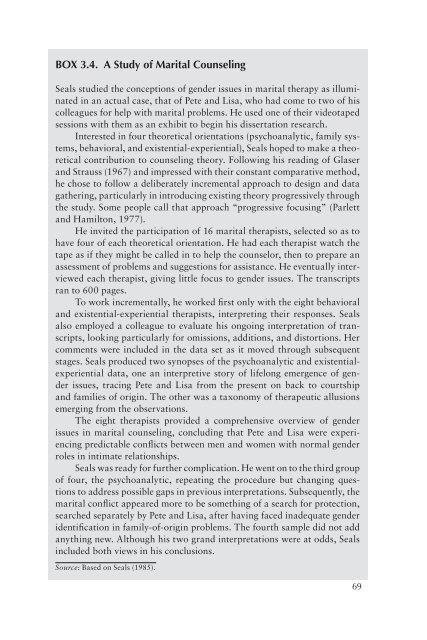How Things Work - Doha Academy of Tertiary Studies
How Things Work - Doha Academy of Tertiary Studies
How Things Work - Doha Academy of Tertiary Studies
You also want an ePaper? Increase the reach of your titles
YUMPU automatically turns print PDFs into web optimized ePapers that Google loves.
BOX 3.4. a study <strong>of</strong> Marital counseling<br />
Seals studied the conceptions <strong>of</strong> gender issues in marital therapy as illuminated<br />
in an actual case, that <strong>of</strong> Pete and Lisa, who had come to two <strong>of</strong> his<br />
colleagues for help with marital problems. He used one <strong>of</strong> their videotaped<br />
sessions with them as an exhibit to begin his dissertation research.<br />
Interested in four theoretical orientations (psychoanalytic, family systems,<br />
behavioral, and existential-experiential), Seals hoped to make a theoretical<br />
contribution to counseling theory. Following his reading <strong>of</strong> Glaser<br />
and Strauss (1967) and impressed with their constant comparative method,<br />
he chose to follow a deliberately incremental approach to design and data<br />
gathering, particularly in introducing existing theory progressively through<br />
the study. Some people call that approach “progressive focusing” (Parlett<br />
and Hamilton, 1977).<br />
He invited the participation <strong>of</strong> 16 marital therapists, selected so as to<br />
have four <strong>of</strong> each theoretical orientation. He had each therapist watch the<br />
tape as if they might be called in to help the counselor, then to prepare an<br />
assessment <strong>of</strong> problems and suggestions for assistance. He eventually interviewed<br />
each therapist, giving little focus to gender issues. The transcripts<br />
ran to 600 pages.<br />
To work incrementally, he worked first only with the eight behavioral<br />
and existential-experiential therapists, interpreting their responses. Seals<br />
also employed a colleague to evaluate his ongoing interpretation <strong>of</strong> transcripts,<br />
looking particularly for omissions, additions, and distortions. Her<br />
comments were included in the data set as it moved through subsequent<br />
stages. Seals produced two synopses <strong>of</strong> the psychoanalytic and existentialexperiential<br />
data, one an interpretive story <strong>of</strong> lifelong emergence <strong>of</strong> gender<br />
issues, tracing Pete and Lisa from the present on back to courtship<br />
and families <strong>of</strong> origin. The other was a taxonomy <strong>of</strong> therapeutic allusions<br />
emerging from the observations.<br />
The eight therapists provided a comprehensive overview <strong>of</strong> gender<br />
issues in marital counseling, concluding that Pete and Lisa were experiencing<br />
predictable conflicts between men and women with normal gender<br />
roles in intimate relationships.<br />
Seals was ready for further complication. He went on to the third group<br />
<strong>of</strong> four, the psychoanalytic, repeating the procedure but changing questions<br />
to address possible gaps in previous interpretations. Subsequently, the<br />
marital conflict appeared more to be something <strong>of</strong> a search for protection,<br />
searched separately by Pete and Lisa, after having faced inadequate gender<br />
identification in family-<strong>of</strong>-origin problems. The fourth sample did not add<br />
anything new. Although his two grand interpretations were at odds, Seals<br />
included both views in his conclusions.<br />
Source: Based on Seals (1985).<br />
69

















